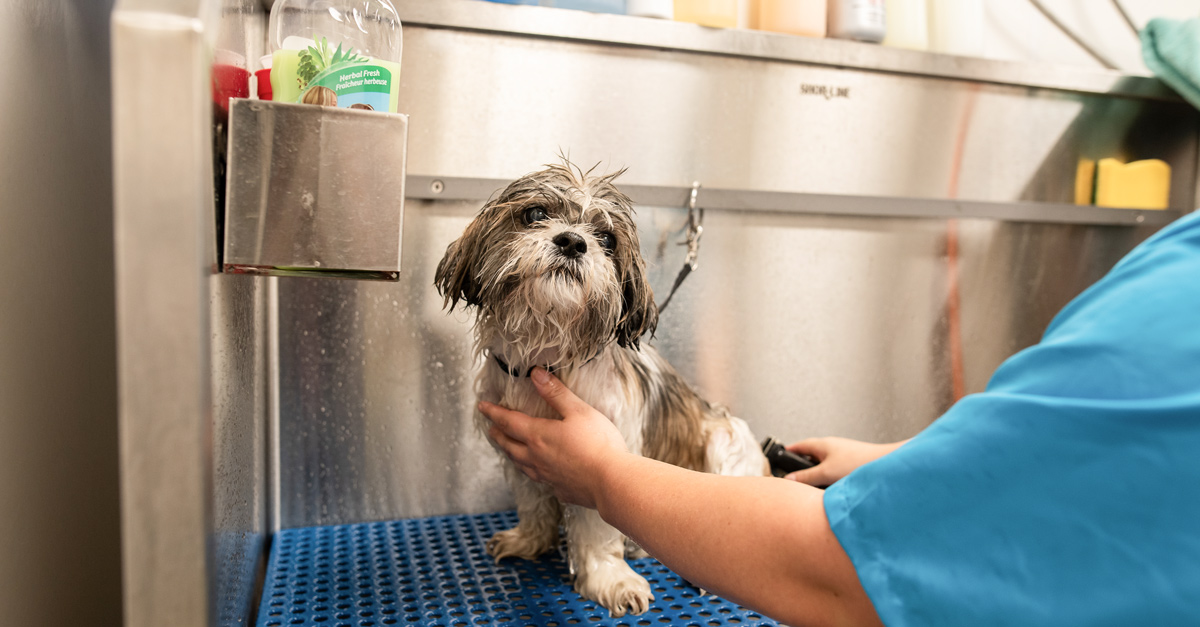At Pawsperity, we see many dogs every day, all with their own unique temperaments and levels of tolerance for being bathed and groomed. We have observed a handful of actions that pet owners can take to help their dogs adjust to the grooming process more quickly. These things benefit not only the dog, who learns to relax and enjoy a lifetime of grooming, but they also make the job much easier for the groomer.
Here are top five tips for setting your pet up for grooming success:
1. Start young.
Once your puppy is at least 8–12 weeks old, or after they have had a few rounds of their vaccinations, schedule their first grooming appointment, even if this is just for a bath and nail trim. This gets them used to the grooming process early, so it isn’t quite as scary.
2. Handle your pet’s feet regularly.
Gently rubbing and touching their feet helps dogs become tolerant of getting their nails trimmed. Please do not irritate, agitate, or force your dog to allow you to handle their feet, though. Use positive reinforcement, whether it is with treats, verbal reassurance, or petting and loving on your dog when you get the correct behavior from them.
3. Brush and comb their coat frequently.
Regularly brushing and combing your pet at home will not only keep their coat in good condition; it will also make their grooming and deshedding experience more pleasant. We recommend a slicker-style brush (a popular brand is Tuffer than Tangles) and a metal comb to search the coat for tangles or matts. You’ll know your dog is fully brushed out when the comb moves from the skin through the coat smoothly.
If you bathe your dog at home, be sure to thoroughly brush out their coat after they are fully dry. The last thing you want to create is bath matts, which are serious knots that start deep inside the coat, closest to the dog’s skin. These painful tangles and matts can also attach in any areas of friction, such as where their collar or harness may rub. When tangles and matts reach this level, the groomer is often forced to shave the dog’s coat. There is no magical product that will remove these matts. Aside from shaving, the only option is to brush them out by hand, which is extremely painful and dangerous for the dog, as well as timely and costly for you.
4. Help your dog be dryer accepting.
Please avoid teasing your dog with the vacuum cleaner or hair dryer at home. Being fearful of these noises makes it very difficult for the groomer to acclimate your dog to being dried and fluffed out in a salon. Drying is a very important part of the process for dog groomers—it helps to prepare dogs for their groom, it removes any dead undercoat, and it allows the groomer to clearly see the dog’s skin to identify any skin irregularities.
5. Exercise your dog before their grooming appointment.
There is nothing harder for a groomer to work with than a dog with pent up energy. Just imagine a child that is forced to sit in a chair all day with no breaks—they would become agitated and likely get into some form of trouble. Regular exercise will help to regulate your dog’s energy level, making them happier at home and at the grooming salon.
Additionally, keep in mind that groomers are using very sharp tools on your dog for the entire grooming process. It is much harder to keep the dog safe and to provide the best haircut if they are extremely wiggly. Giving your dog regular exercise will help them come out of the salon looking and feeling their best.
